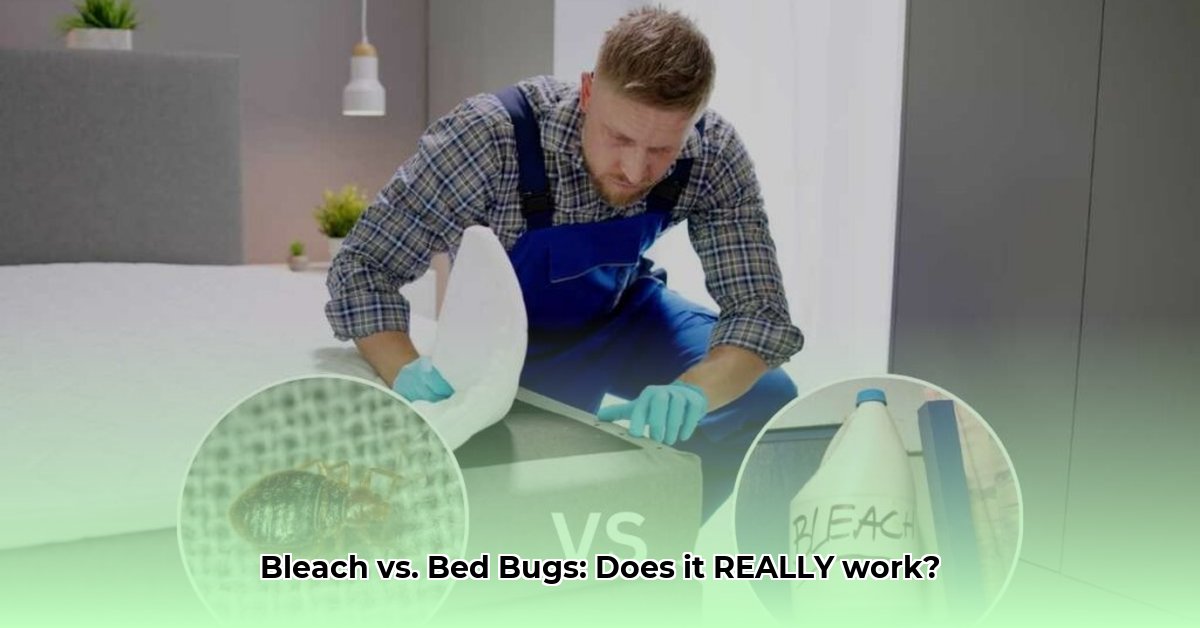So, you’ve discovered bed bugs. It’s a nightmare scenario, and the urge to grab the strongest cleaner you own is completely understandable. Bleach might seem like the ultimate weapon, but when it comes to bed bugs, it’s more myth than miracle cure. Let’s debunk the bleach myth and explore truly effective solutions.
The Bleach Myth: Why It’s Not the Solution
The idea that bleach eradicates bed bugs is a persistent misconception. While it can kill bed bugs on contact, it’s simply not a practical or effective solution for an infestation. Think of it like trying to put out a house fire with a spray bottle – you might extinguish a few flames, but the blaze will rage on.
Why Bleach Fails: A Deeper Dive
Bleach’s active ingredient, sodium hypochlorite, disrupts cell membranes and can kill bed bugs directly. However, bed bugs are masters of hiding. They burrow deep within mattresses, furniture, and wall crevices, far beyond the reach of a surface-level bleach spray. These hidden bugs and their protected eggs will likely survive, rendering your bleach efforts futile. Furthermore, the strong odor of bleach may actually repel bed bugs, driving them further into hiding.
Bleach also poses safety risks. Inhaling the fumes can irritate your respiratory system, while direct skin contact can cause burns. It can damage fabrics and furniture and is highly toxic to pets. Mixing bleach with other cleaners can create dangerous chemical reactions.
Effective Bed Bug Control: Proven Strategies
Now that we’ve debunked the bleach myth, let’s explore proven strategies that actually work:
Heat Treatment: Turning Up the Heat
High temperatures are lethal to bed bugs at all life stages. Professional heat treatment, using specialized equipment to raise room temperatures, is highly effective. DIY heat treatments, like using a steamer, can target specific areas, but may not eliminate a widespread infestation.
Insecticides: Targeted Treatments
EPA-approved insecticides designed for bed bugs can be effective. Always follow label instructions carefully and prioritize safety. Professional pest control services often have access to stronger, more effective insecticides.
Diatomaceous Earth: A Natural Approach
Diatomaceous earth (DE) is a non-toxic powder composed of fossilized diatoms. It damages bed bugs’ exoskeletons, causing dehydration and death. While generally safe, avoid inhaling large amounts of DE dust.
Professional Pest Control: Expert Help
For severe infestations, professional pest control is often the best solution. Experts have the knowledge, equipment, and targeted treatments to effectively eliminate bed bugs and prevent their return.
Prevention: Your Best Defense
Proactive measures can significantly reduce your risk of a bed bug infestation:
Mattress Encasements: Protective Barriers
Encasements create a barrier that prevents bed bugs from infesting your mattress and box spring. They also trap any existing bed bugs, preventing them from escaping and biting.
Regular Cleaning and Inspection: Staying Vigilant
Frequent vacuuming, especially in crevices and seams, removes bed bugs and their eggs. Regularly inspect bedding, furniture, and luggage for signs of bed bugs.
Travel Precautions: Protecting Your Home
When traveling, inspect hotel rooms for bed bugs before unpacking. Keep luggage off the floor and consider using luggage encasements. Wash clothes in hot water and dry on high heat immediately upon returning home.
Comparing Bed Bug Treatment Methods
| Method | Effectiveness | Safety | Cost |
|---|---|---|---|
| Bleach | Low | Low | Low |
| Heat Treatment | High | Medium | Medium-High |
| Insecticides | Medium-High | Medium | Low-Medium |
| Diatomaceous Earth | Medium | High | Low |
| Professional Pest Control | High | High | High |
Conclusion: Focus on Effective Solutions
While bleach may seem like a quick fix, it’s ultimately ineffective and potentially harmful. Prioritize proven methods like heat treatment, insecticides, and professional pest control. Above all, focus on prevention to avoid the stress and hassle of a bed bug infestation. Remember, current research suggests that integrated pest management strategies, combining various approaches, are often the most effective. Consult a pest management professional or resources from reputable organizations like the EPA for the most up-to-date information and tailored advice.
- Bento Box Trays Streamline Restaurant Meal Presentation and Transport - December 13, 2025
- Plastic Bento Boxes Face Scrutiny Over Sustainability Impacts - December 11, 2025
- Bento Tray Revolutionizes Organized Meal Transport and Presentation - December 10, 2025










